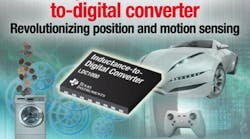TI stakes claim to the industry’s first inductance-to-digital converter (LDC) with the LDC1000, a new data converter that uses coils and springs as inductive sensors to deliver sub-micron resolution with increased reliability and greater flexibility. Inductive sensing is a contactless sensing technology, immune to nonconductive contaminants, that can be used to measure the position, motion or composition of a metal or conductive target, as well as detect the compression, extension or twist of a spring. LDC technology can be located remotely from the electronics and consumes less than 8.5 mW during standard operation and less than 1.25 mW in standby mode. Applications for inductive sensing range from simple push buttons, knobs and on/off switches to high-resolution heart rate monitors, turbine flow meters and high-speed motor/gear controllers. The LDC1000EVM, which includes an MSP430F5528 MCU, is available now for $29. TI’s new WEBENCH Inductive Sensing Designer allows creation a custom sensor coil and configuration of the LDC. The LDC1000 is available now in a 16-pin, 4 x 5 mm SON package for $2.95 each/1,000. An automotive-qualified version will be available the first half of 2014.
Comments
